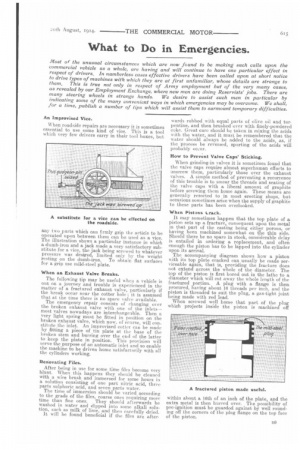What to Do in Emergencies.
Page 17

If you've noticed an error in this article please click here to report it so we can fix it.
Most of the unusual circumstances which are now found to be making such calls upon the commercial vehicle as a whole, are having and will continue to have one particular effect in respect of drivers. In numberless cases effective drivers have been called upon at short notice to drive types of machines with which they are at first unfamiliar, whose details are strange to them. This is true not only in respect of Army employment but of the very many cases, as revealed by our Employment Exchange, where new men are doing Reservists' jobs. There are many steering wheels in strange hands. We desire to assist such men in particular by indicating some of the many convenient ways in which emergencies may be overcome. We shall, for a time, publish a number of tips which will assist them to surmount temporary difficulties.
An Improvised Vice.
When roadside repairs are necessary it is sometimes essential to use some kind of vice. This is a tool which very few drivers carry in their tool boxes, but
any two parts which can firmly grip the article to be operated upon between them can be used as a vice. The illustration shows a particular instance in which a dumb-iron and a jack made a very satisfactory substitute for a vice, the jack being screwed to whatever pressure was desired, limited only by the weight
resting on the dumb-iron. To obtain flat surfaces for a grip use mild-steel plate.
When an Exhaust Valve Breaks.
The following tip may be useful when a vehicle is out on a journey and trouble is experienced in the matter of a fractured exhaust valve, particularly if the break occur near the cotter hole ; it is assumed that at the time there is no spare valve available.
The emergency repair consists of changing over the broken exhaust valve with one of the inlets— most valves nowadays are interchangeable. Then a very light spring must be fitted in position on the broken exhaust valve, which now, of course, will constitute the inlet. An improvised cotter can be made by fitting a piece of tin plate at the base of the broken stem and burring over the end of the latter to keep the plate in position. This provision will serve the purpose of an automatic inlet and so enable the machine to be driven home satisfactorily with all the cylinders working.
Renovating Files.
After being in use for some time files become very blunt. When this happens they should be cleaned With a wire brush and immersed for some hours in a solution consisting of one part nitric acid, three parts sulphuric acid, and seven parts water. The time of immersion should be varied according to the grade of the files, coarse ones requiring more time than fine ones. They should afterwards be washed in water and dipped into some alkali solution, such as milk of lime, and then carefully dried. It will be found beneficial if the files are after
wards rubbed with equal parts of olive oil and turpentine, and then brushed over with finely-powdered coke. Great care should be taken in mixing the acids with the water, and it must be remembered that the water should always be added to the acids, as, if the process be reversed, spurting of the acids will probably occur.
How to Prevent Valve Caps' Sticking.
When grinding-in valves it is sometimes found that the valve caps require almost superhuman efforts to unscrew them, particularly those over the exhaust valves. A simple method of preventing a recurrence of this trouble is to smear the threads and seating of the valve caps with a liberal amount of graphite before screwing them home again. These means arc generallyresorted to in most erecting shops, but occasions sometimes arise when the supply of graphite to these parts has been overlooked.
When Pistons 1...rack.
It may sometimes happen that the top plate of a piston sets up a fracture, consequent upon the metal in that part of the casting being either porous, or having been machined somewhat on t7he thin side. Should there be no spare in stock, considerable delay is entailed in ordering a replacement, and often enough the piston has to be lapped into the cylinder upon its arrival.
The accompanying diagram shows how a piston with its top plate cracked can usually be made serviceable again, that is, providing the fracture does not extend across the whole of the diameter. The top of the piston is first bored out in the lathe to a diameter which will cut away the whole length of the fractured portion. A plug with a flange is then procured, having about 16 threads per inch, and the piston is threaded to suit the plug, a gas-tight joint being made with red lead. When screwed well home that part of the plug which projects inside the piston is machinedoff within about a 16th of an inch of the plate, and the extra metal is then burred over. The possibility of pre-ignition must be guarded against by well rounding off the corners of the plug flange on the top face of the piston.






































